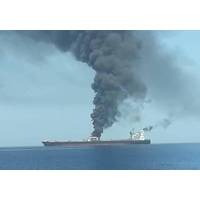Oil Prices Fall as Focus Shifts to Ukraine Peace Talks

Oil prices fell more than $1 on Thursday as investors shifted focus back to Russia-Ukraine peace talks and monitored potential fallout from a U.S. seizure of a sanctioned oil tanker off the coast of Venezuela.Brent crude futures were down $1.1, or 1.8%, at $61.11 a barrel at 1408 GMT, hovering near the lowest since Oct. 21.U.S. West Texas Intermediate crude fell $1.07, also around 1.8%, to $57.39 a barrel, its lowest in over two weeks.Russian Foreign Minister Sergei Lavrov said on Thursday that a visit to Moscow this month by U.S.
Oil Prices Steady with Ukraine Peace Talks, US Interest Rate Decision Looms

Oil prices steadied on Tuesday after falling 2% in the previous session, with investors keeping a close eye on peace talks to end Russia's war in Ukraine, concerns about ample supply and a looming decision on U.S. interest rates.Brent crude futures edged 3 cents higher to $62.52 a barrel at 1317 GMT. U.S. West Texas Intermediate crude gained 4 cents at $58.92 a barrel.Both contracts fell by more than $1 a barrel on Monday after Iraq restored production at Lukoil's West Qurna 2 oilfield…
Iranian Tanker Hit by Missiles, Oil Rises
Oil prices jumped more than 2% on Friday, October 11, 2019, after Iranian media said a state-owned oil tanker had been struck by missiles in the Red Sea near Saudi Arabia, raising the prospect of supply disruptions weeks after attacks on Saudi oil plants.The Suezmax crude tanker Sabiti was ablaze and suffered heavy damage after being hit by two missiles, Iranian media reported.Both oil benchmarks recorded their biggest daily rise since Sept. 16, the first…
Oil Prices Jump 2% After Tanker Attacks

Oil prices settled 2.2% higher on Thursday after attacks on two oil tankers in the Gulf of Oman stoked concerns of reduced crude trade flows through one of the world's key shipping routes.The attacks near Iran and the Strait of Hormuz reignited worries about an impact to flows from the Middle East if insurance companies begin to reduce coverage for voyages through the region and additional shipping companies suspend new bookings, analysts said.Such a disruption "could further exacerbate the supply problem…
Oil Falls Below $60 a barrel as Inventories Stay High

North Sea Brent crude oil fell below $60 a barrel on Thursday, under pressure from high global inventories and a smaller-than-expected drawdown in U.S. crude stockpiles."The energy complex is drifting lower as sellers continue to bask in the bearish afterglow of yesterday's (U.S.) stats," PVM Oil analyst Stephen Brennock said.Brent crude was down 30 cents at $59.85 per barrel by 1425 GMT. U.S. light crude was 50 cents lower at $50.65.Global oil supply has outstripped demand over the last six months…
OPEC's Focus on Stocks comes with Risk: Kemp
The Organization of the Petroleum Exporting Countries (OPEC) is sticking doggedly to its plan to cut commercial oil inventories down to the five-year average to rebalance the oil market. But in doing so, the organisation risks tightening the market too much, sending prices sharply higher and encouraging a faster-than-expected acceleration in production from U.S. shale producers. Saudi Arabia’s oil minister, who is the organisation’s de facto leader, has…
Rising U.S. Output Impacts 2018 Global Market Balance
The global oil market will likely show a surplus in the first half of 2018, as rising U.S. supply offsets OPEC's discipline in maintaining its production cuts for the whole of next year, the International Energy Agency (IEA) said on Thursday. "Total supply growth could exceed demand growth: indeed, in the first half the surplus could be 200,000 barrels per day (bpd) before reverting to a deficit of about 200,000 bpd in the second half, leaving 2018 as a whole showing a closely balanced market," the Paris-based IEA said in its monthly oil market report.
Force Majeure Declared on Some North Sea Liftings
Pipeline shut on Dec. 11; repair work could last several weeks. Deliveries of crude oil through the Forties pipeline in the North Sea are under force majeure for the first time in decades and operator INEOS said on Thursday there was no timeline yet for repair work that could last several weeks. The 169-km pipeline, which carries around a quarter of all North Sea crude output and around a third of Britain's total offshore gas production, has been closed since Monday, following the discovery of a small crack in part of the system onshore in Scotland.
Booming Demand Erodes Oil Inventories: Kemp
Global oil consumption is growing rapidly, helping account for the decline in reported inventories, the recent surge in prices and the shift in futures markets from contango to backwardation. Consumption is much harder to measure than production, which is why the demand side of the market receives less attention. Even in the advanced economies, consumption data is only available with a delay of two months or more, and reliable data from emerging economies often not at all.
OPEC Must Think About Exit Strategy: Kemp
Smoothly exiting from the current output pact, and perhaps replacing it with another agreement, has become the most important policy question for the Organization of the Petroleum Exporting Countries and its allies. Under the current “declaration of cooperation”, issued in December 2016, OPEC with Russia and some non-OPEC countries have pledged to limit their output. Production limits were originally intended to apply for six months between January and June 2017 but have since been extended for a further nine months until the end of March 2018.
China's Crude Oil Buying Spree Set to Continue
China has built its crude oil stockpiles at a record pace in 2017 and while its purchases could tail off towards the year-end, inventories could hit the billion-barrel mark in six months, the International Energy Agency said. China has spent around $24 billion on building its crude reserves since 2015, at an average of $50 a barrel, and now holds around 850 million barrels of oil in inventory. While China's spending on "excess" crude is tiny, given its $680 billion current account surplus since early 2015…
Goodbye Contango? Oil's Long March Towards Backwardation
“The rebalancing of the oil market desired by the leading producers has been a stubborn process,” the International Energy Agency wrote in its latest monthly oil market report. The agency’s evident frustration about the slow and uneven pace of rebalancing, and the conflicting signals about whether it is happening at all, is shared by many traders, analysts and investors. “The medium-term outlook for oil still looks challenging with, if anything, balances for 2018 having deteriorated in recent weeks,” hedge fund manager Andy Hall wrote to investors this month.
OPEC and US Shale Drillers Are on a Collision Course

The oil market is on an unsustainable course with output from U.S. shale and other non-OPEC sources increasing rapidly, while OPEC and its allies trim production to reduce inventories and prop up prices. The International Energy Agency (IEA) projects non-OPEC output will increase by 1.5 million barrels per day (bpd) in 2018 (“Oil Market Report”, IEA, June 2017). If that proves correct, non-OPEC suppliers will capture all the increase in demand next year, because the IEA predicts consumption will increase by only 1.4 million bpd.
OPEC: Oil Stocks Need to Fall Further
OPEC Secretary General Mohammad Barkindo said on Thursday that a global oil inventory overhang was declining but oil stocks still needed to fall closer to the five-year industry average. "While it is evident that the market rebalancing is now moving forward and investment specifically in short-cycle projects is returning, it is essential we do not take our eyes off our desired goals," he told a conference in Paris. "We need to see the global stock overhang move closer to its five-year average.
Goodhart's Law and OPEC's output deal: Kemp
No evidence has emerged of cheating on the OPEC/non-OPEC production agreement so far. But Goodhart's Law is a reminder traders should expect countries to try to circumvent any target once it has been chosen. Goodhart's Law states that any observed statistical regularity will tend to collapse once pressure is placed upon it for control purposes ("Monetary Theory and Practice", Goodhart, 1983). Charles Goodhart was a Bank of England official and he was expressing…
Oil Prices Rise as Middle East Producers Confirm Supply Cuts
Oil prices rose on Tuesday, supported by strong demand in Asia and supply cuts by Abu Dhabi, Kuwait and Qatar as part of production curbs organized by OPEC and other exporters. Gains were modest, with the market pressured as investors closed positions to take profits on strong gains the day before. Traders said there was significant profit-taking after oil shot to mid-2015 highs earlier this week, boosted by the deal reached by the Organization of the Petroleum Exporting Countries and other exporters to cut output by a combined 1.8 million barrels per day (bpd).
Oil Demand to Rise Swiftly, Output Cut Impact Uncertain
Global oil demand will rise more strongly than expected in 2016 and 2017, although it is too soon to assess the impact of a joint cut in supply by the world's largest producers, the International Energy Agency said on Tuesday. In its monthly oil market report, the IEA said revisions to its estimate of Chinese and Russian consumption had prompted it to raise its forecast for global oil demand growth this year by 120,000 barrels per day (bpd) to 1.4 million bpd, and to lift its forecast for 2017 by 110,000 bpd to 1.3 million bpd.
Oil Slips as Fuel Glut Weighs
IEA sees glut far into 2017 unless OPEC cuts output; stronger dollar also weighs on oil prices. Oil prices slipped on Friday as the market refocused on a persistent fuel supply overhang that is not expected to abate unless OPEC and other producers cut their output significantly. International Brent crude futures traded at $45.24 per barrel at 1145 GMT, down 60 cents from their last close. U.S. West Texas Intermediate (WTI) crude futures were trading 66 cents lower at $44.00 per barrel.
IEA: 2017 Market Awash with Oil Without OPEC Cut
The oil market surplus may run into a third year in 2017 without an output cut from OPEC, while escalating production from exporters around the globe could lead to relentless supply growth, the International Energy Agency said on Thursday. In its monthly oil market report, the group said global supply rose by 800,000 barrels per day in October to 97.8 million bpd, led by record OPEC output and rising production from non-OPEC members such as Russia, Brazil, Canada and Kazakhstan.
Saudis Gamble with Price, Hope to Keep Market Share
The Organisation of the Petroleum Exporting Countries surprised oil traders and analysts by announcing a production deal following a hastily convened extraordinary meeting in Algiers on Wednesday. The Algiers agreement seems to have been designed to engineer an increase in prices by changing market sentiment rather than reducing the physical supply of crude. OPEC issued a statement of just under 700 words following the meeting. (1) OPEC's 14 members committed…